
Many businesses use key performance indicators (KPIs) and benchmarking to track their progress and inform their decisions. For most industries, this is a relatively straight-forward process.
For the construction industry however, determining KPIs that drive profitability is a complex task and often adds several challenges. But why is this? It’s no secret that the industry is not first out of the blocks in adopting new technology, therefore recording and analysing data in relation to performance is more difficult. Supply chain and partners operate in silos, gaps in technology adoption and user maturity levels vary. The differing size and scale of projects construction companies undertake is also a factor. So how do we get a picture of what’s happening in UK and Ireland?
Autodesk commissioned Censuswide to carry out a survey of more than 400 contractors, subcontractors and project owners in the UK and Ireland to identify and analyse construction process management and benchmarking. The study found that there are seven KPIs that most companies say are especially useful when it comes to interpreting overall performance.
The UK and Ireland are certainly in close proximity and we would say they are similar, but despite the short distance apart there are some fundamental and interesting differences in benchmarking and performance measurement practices between the two. Below, we explore the seven KPIs to construction and the differences identified between the construction industry in the UK and Ireland.
Errors on construction documents at the tender phase can ripple through a project. Seeing the issues that arise and comparing them with similar previous projects can enable contractors to work to avoid the same problems in future. Only 13% of respondents from construction companies in the UK capture errors at tender phase compared to 33% in Ireland.
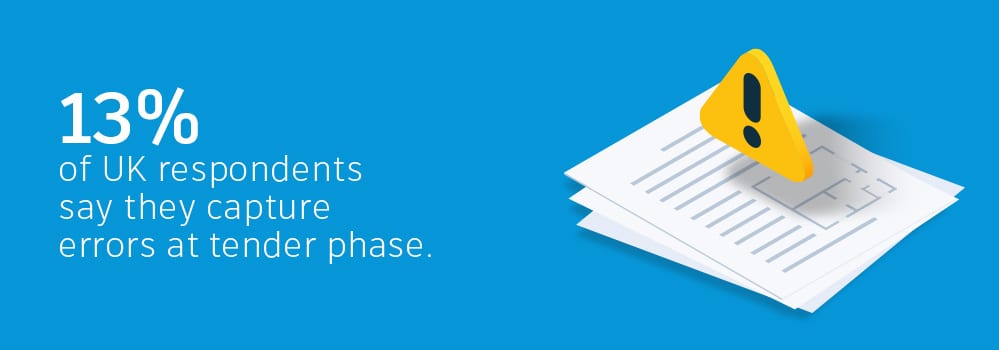
Although Irish respondents are more likely to capture errors early, 33% his number is still surprisingly low as starting the project right is often cited as key to the success of a project.
Requests for Information (RFIs) and responses are another point in the project process where errors can occur, so we sought to determine how often those surveyed log RFIs and responses. We also asked how often those who create such a log compare it to previous similar projects and use it to proactively reduce risk.
26% of those surveyed in the UK create a log of RFIs and responses and from those respondents 71% said it is a valuable exercise. Overall, 66% of all respondents in the UK said creating such a log more frequently would be valuable. Interestingly, in Ireland only 57% of respondents found this a valuable exercise but 79% of respondents in Ireland complete this activity on their projects.
In Ireland, 28% of respondents compare their log of RFIs and responses logs to past projects with 19% of respondents in the UK doing this. Irish respondents also reported that more often than not a log of RFIs and responses result in proactive risk reduction actions, suggesting it is a valuable exercise.
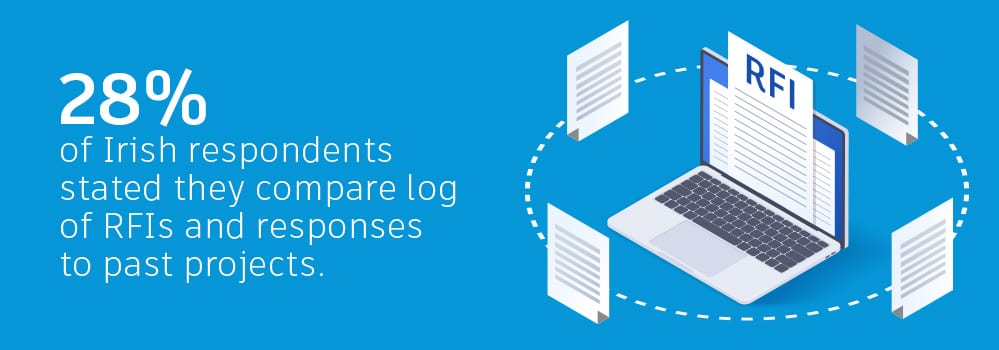
The study found that there is significant opportunity for contractors and project owners in the UK to improve data tracking in the early stages of projects to prevent delays and increased costs as projects progress. Those who do track problems in the UK are about as likely as their Irish counterparts to find it valuable to do so. Even when they track issues on their projects, UK respondents are still less likely to compare the issues tracked with previous similar projects.
When the original project contract or schedule gets amended, it can cause delays and may result in additional costs being incurred. We asked how often respondents collect and document change orders, including turnaround times, root causes and programme impact. In the UK 23% of respondents document change orders, of those 66% see value in doing this which is the same response rate as their Irish counterparts. In Ireland, while documenting change orders was something 38% of respondents do on projects there is still a gap between those who find it valuable and those who do this.

To gain insight into the programming process and the prevalence of good programme maintenance, we asked respondents how often they updated their project programmes. We also enquired about related activities and outcomes, including the financial effect of slippages.
One area where contractors and project owners in the UK and Ireland say they are less than efficient is the project schedule. The study found that respondents in both the UK and Ireland updated their project programmes at around the same frequency. 41% of respondents in Ireland stated that this is something they do monthly compared to 36% of respondents in the UK. Irish respondents were less likely to update the programme every day or every week, tending to leave it longer between updates. Perhaps as a result, they are also significantly more likely to take longer to update a project programme after becoming aware of a situation that demands they update it. For improved performance on projects and better collaboration, more frequent updates make for better project performance so taking the time is worthwhile.

Being able to track and manage safety and inspection issues is crucial to sound construction project management. We asked respondents if and how they are using software to manage safety and/or inspections for their construction projects.
While only 29% of respondents in the UK use software to manage safety and/or inspections during construction, 71% of those who do say it is valuable or very valuable. More respondents in Ireland (33%) use software to manage safety and/or inspections on 51-75% of their projects. As well as the obvious personal cost to individuals who suffer injuries, there is also a material cost to the project, in terms of delays, damaged equipment and insurance or damages claims. The construction industry remains one of the highest risk industries when it comes to worker fatalities so investing in technology to protect workers is of the upmost importance.
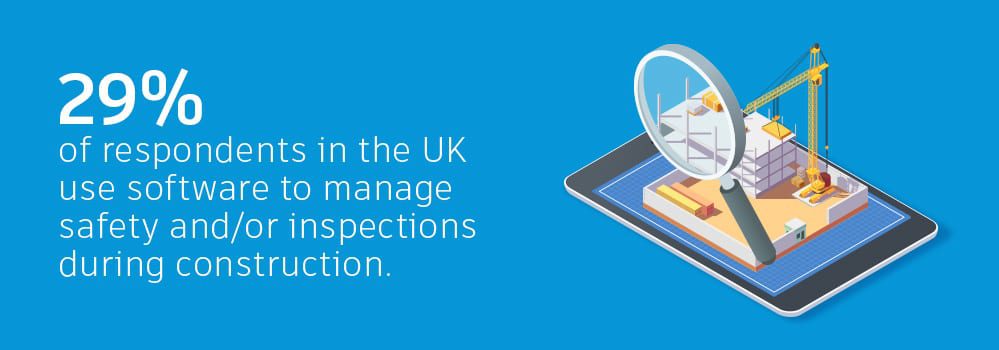
When it comes to effective construction project management, high levels of productivity on site and in the office are paramount. With a global productivity growth rate of only 1% a year for the past 20 years the construction industry needs to rethink their approach to increasing productivity, as a McKinsey Global Institute study pointed out. We asked respondents about the factors they believed are most likely to decrease productivity.
The study found that problems with coordination and communication between key project team members was one of the contributing factors to a decrease in productivity in both the UK and Ireland. Problems with quality management affected 39% of respondents in the UK compared to 33% in Ireland. 36% of Irish respondents stated problems with issue management had a high impact on their projects compared with their UK counterparts. Whilst the survey found that more respondents in Ireland kept a log of RFIs and responses, less found it valuable and there seems to be a disconnection between resolving issues even if they are logged.
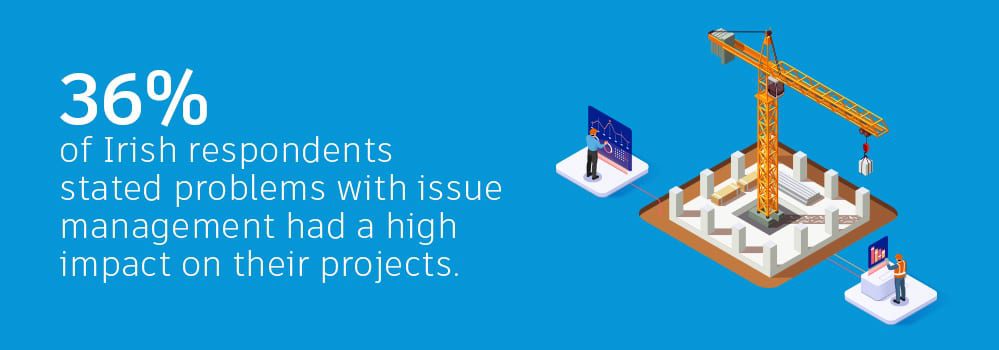
While snag lists were traditionally done at the end of construction projects, snagging on the go can prove beneficial. We asked those surveyed which approach they prefer and if they use software to manage snagging and project handover. Getting off the job isn’t always easy, so we also asked respondents about the closeout problems they see and the financial impact these can have.
Irish respondents were especially likely to say that using software to manage snagging and handover activities was valuable, with 81% using software in this way and 90% of that group saying it is valuable or very valuable to do so. 66% of respondents in the UK saw continuous snagging as valuable meaning there’s a bigger disparity between the UK and Ireland in their approach to snagging.
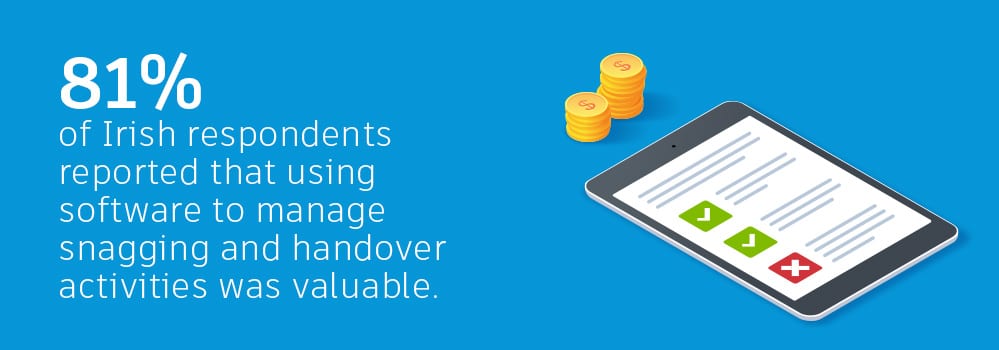
Furthermore, those surveyed in Ireland are twice as likely as their UK counterparts to snag as they go. This may be driven by their beliefs around costs - Irish respondents were also twice as likely to say that not being able to finish a project by the planned completion date would have a high or very high impact on their profitability.
It’s evident that there’s still a way to go with embedding data and technology into the construction lifecycle process. Perhaps understanding the true value of what this data can do on a project would incentivise those working in the industry to track it more. Using these insights to inform future bids or negotiations with clients would be a step-change for the industry. Even data alone on the average number of change orders per project provides asset and project owners with richer information which they can use to base their decisions or to influence their commercial models.
Some construction companies are already way ahead on their journey to digitise their ways of working whereas some companies are just getting started. There’s no denying however, the power of data in enabling smarter decisions, increasing transparency and improving predictability. Explore more of our findings in our The Ultimate Guide to Benchmarking your Workflows here.
In addition to the full report we looked at the UK and Ireland survey responses individually and have put together 1-page snapshots highlighting some of the key differences in how respondents in the UK and Ireland approach data tracking and benchmarking.
Do your current processes give you the data you need to capture critical project information, benchmark project performance, and maintain quality control in construction projects? Take this free assessment to see how you measure up:

May we collect and use your data?
Learn more about the Third Party Services we use and our Privacy Statement.May we collect and use your data to tailor your experience?
Explore the benefits of a customized experience by managing your privacy settings for this site or visit our Privacy Statement to learn more about your options.